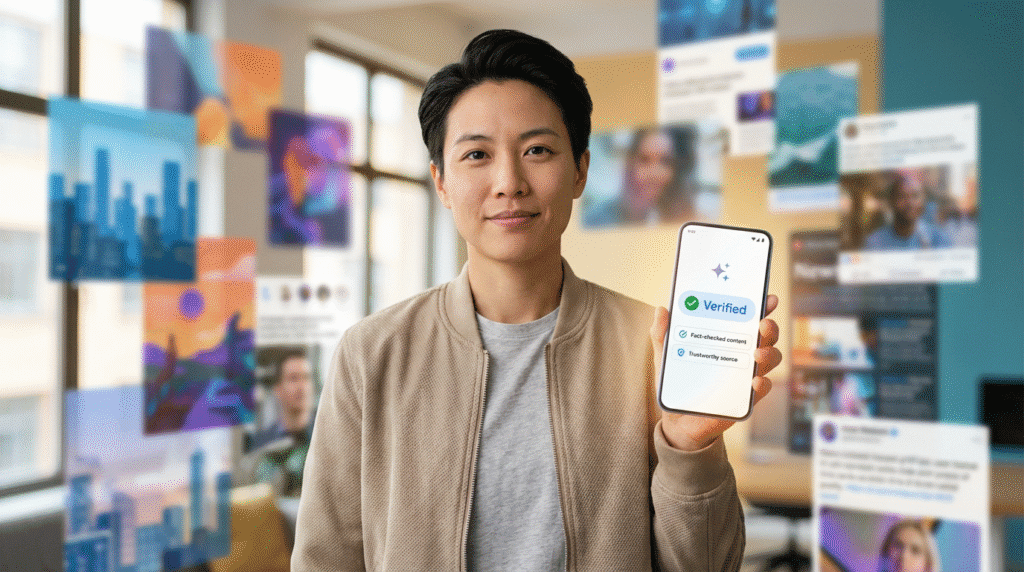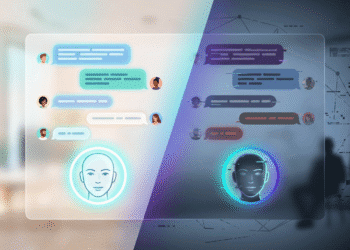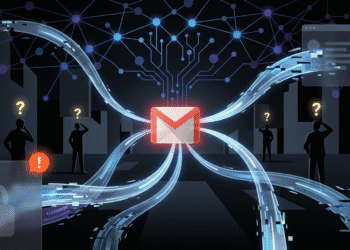Tech giant rolls out SynthID watermark detection in Gemini app, marking significant step toward transparency in era of deepfakes and AI-generated content

The line between real and artificial has never been more blurred. As AI-generated images flood social media feeds, news outlets, and messaging apps, a simple question haunts internet users everywhere: Is this real, or did a machine make it? Google just gave everyone a free tool to help answer that question.
Starting this week, the tech giant rolled out a groundbreaking feature in its Gemini app that allows users to verify whether an image was created or edited using Google’s artificial intelligence tools. The move represents a significant push toward transparency in an increasingly synthetic digital landscape where distinguishing fact from fabrication has become a daily challenge.
How Google’s New Detection System Works
The verification system is remarkably simple to use. Upload any image to the Gemini app and ask a straightforward question like “Was this created with Google AI?” or “Is this AI-generated?” Gemini then analyzes the image, checking for invisible digital watermarks embedded during the creation process.
At the heart of this technology lies SynthID, Google’s proprietary digital watermarking system developed by Google DeepMind in 2023. Unlike visible watermarks that can be easily cropped out or removed, SynthID embeds imperceptible signals directly into the pixels of AI-generated images. These invisible markers survive common modifications like resizing, filtering, and compression, making them far more durable than traditional watermarking methods.
“We introduced SynthID in 2023,” Google explained in its announcement. “Since then, over 20 billion AI-generated pieces of content have been watermarked using SynthID.”
The system doesn’t just rely on watermark detection. Gemini 3 Pro, the latest version of Google’s AI model, also uses its own reasoning capabilities to spot telltale signs of AI generation. It can identify subtle artifacts that casual viewers might miss unnaturally smooth “AI skin,” objects with inconsistent physics, remnants of common prompting terms appearing in text, or file-naming conventions typically used by generative AI applications.
A Growing Problem Demands New Solutions
The timing of this rollout couldn’t be more critical. AI-generated imagery has evolved from a novelty to a genuine concern for media professionals, fact-checkers, and everyday users. What once required expert analysis to detect now appears indistinguishable from authentic photography to the untrained eye.
Many people now pause while scrolling, questioning whether images sent by friends, posts on social media, or random pictures online are genuine or AI-generated. Spotting unnatural patterns or errors was once a simple check, but these signs rarely appear in modern AI outputs.
The stakes are high. From political deepfakes to manipulated news imagery, AI-generated content poses serious risks to public discourse and trust in media. Elections have been influenced by synthetic imagery, and social media platforms struggle to keep pace with the flood of AI-generated content.
Google’s move addresses this growing crisis head-on. The company has been testing its SynthID Detector portal with journalists and media professionals, recognizing that those on the front lines of information verification need reliable tools to combat misinformation.
The Technology Behind the Transparency
SynthID represents a significant advancement in AI content authentication. The watermark is woven into the image structure itself during the generation process, making it far more resistant to tampering than metadata-based solutions.
The system works across Google’s primary generative AI services, including the Gemini app, Nano Banana Pro (Google’s advanced image generation model), Vertex AI (Google Cloud’s enterprise platform), and Google Ads. Every image created through these platforms now receives SynthID watermarks automatically, with no action required from users.
What makes SynthID particularly powerful is its invisibility. The watermark doesn’t alter how an image looks to human eyes, yet it remains detectable through specialized algorithms. This pixel-level integration means the watermark survives even when images are screenshot, re-uploaded, or subjected to various editing processes.
Google has also made SynthID technology available to partners, including Hugging Face and NVIDIA, encouraging broader industry adoption. This open-source approach signals Google’s recognition that solving the AI verification challenge requires collaboration beyond any single company’s ecosystem.
The Catch: A Limited Scope Sparks Debate
Despite its promise, the new feature comes with a significant limitation that has sparked criticism from industry experts and users alike. Gemini can only definitively verify images created by Google’s AI tools. Content generated by competitors like OpenAI’s DALL-E, Midjourney, or Stable Diffusion won’t carry SynthID watermarks, leaving Gemini unable to provide definitive answers about their origins.
This self-contained approach has raised questions about whether Google is prioritizing its brand over industry-wide solutions. Critics point out that while the tool helps build trust in Google’s own products, it falls short of addressing the broader deepfake crisis affecting the entire internet.
“You can now ask Gemini if an image is made with Google’s AI,” noted one tech publication, “but there’s a big catch it won’t flag fakes from elsewhere.”
The irony hasn’t been lost on observers: Google’s AI can both create synthetic images and help detect them, but only its own. This selective detection has led some to question whether the feature serves as a genuine safeguard or merely a proprietary marketing tool.
Beyond Google: Industry Standards and Future Plans

Recognizing these limitations, Google has outlined ambitious plans to expand the system’s capabilities. The company is working to integrate support for C2PA (Coalition for Content Provenance and Authenticity) content credentials, an industry-standard cryptographic metadata system.
C2PA was developed by a consortium founded by Adobe, Microsoft, BBC, The New York Times, and Arm in 2021. The standard provides verifiable information about content origin and authenticity, creating a transparent provenance trail that works across different platforms and AI tools.
Starting this week, images generated by Nano Banana Pro in the Gemini app, Vertex AI, and Google Ads now include C2PA metadata embedded alongside SynthID watermarks. This dual-layer approach combines pixel-level watermarking that survives modifications with signed metadata that creates verifiable attribution.
“Over time, we will also extend our verification approach to support C2PA content credentials,” Google stated, “meaning you’ll be able to check the original source of content created by models and products that exist outside of Google’s ecosystem.”
This future expansion would enable Gemini to verify images from OpenAI, Adobe, Microsoft, Meta, and other platforms that adopt C2PA standards. However, adoption remains fragmented across the industry, and no timeline has been provided for when cross-platform verification will become available.
Real-World Testing: Does It Actually Work?
Independent testing of the new feature has yielded promising results. When users uploaded authentic photographs to Gemini, the system correctly identified them as not created with Google AI. When presented with AI images from ChatGPT which doesn’t use SynthID Gemini recognized the absence of watermarks but still identified “several tell-tale signs” typical of AI-generated imagery.
In one test, Gemini highlighted distorted logos and the “blocky” appearance characteristic of AI generation. It even correctly speculated that ChatGPT might have been the source. When analyzing images edited in Google’s AI studio, the system successfully detected SynthID watermarks and declared the content as “all or part” created with Google AI.
These results suggest that even without universal watermarking, Gemini’s reasoning capabilities provide valuable insights into image authenticity. The system can spot visible watermarks, analyze file naming conventions, and identify visual artifacts that betray AI origins.
What This Means for Different Stakeholders
The rollout impacts multiple groups across the digital ecosystem. For content creators, all images generated through Google tools now carry authentication markers, improving transparency and attribution. This automatic watermarking ensures compliance with emerging disclosure requirements for AI-generated content.
Media organizations and fact-checkers gain a valuable tool for verifying suspicious imagery. Journalists can quickly check whether viral images originated from Google AI, helping them make informed decisions about what to publish or investigate further.
Advertisers benefit from automatic watermarking that ensures transparency in AI-generated advertising creative. As regulations around synthetic media disclosure tighten, this built-in compliance becomes increasingly valuable.
For general users, the feature provides a simple way to satisfy curiosity or concerns about images they encounter online. The straightforward interface upload and ask removes technical barriers to verification.
Current Limitations and Ongoing Challenges
While SynthID represents cutting-edge technology, it’s not foolproof. Extreme modifications, adversarial attacks, or specialized watermark-removal tools can degrade or eliminate the embedded signals. Anyone with basic technical knowledge and malicious intent can potentially defeat the system.
Additionally, C2PA metadata can be stripped when images are screenshot, re-uploaded to certain platforms, or processed through tools that remove EXIF data. While SynthID watermarks often survive these processes better than metadata, they’re not invincible.
Industry experts emphasize that no single watermarking solution offers complete protection. This reality underscores why Google’s layered approach combining multiple authentication methods—represents current best practice rather than a perfect solution.
The feature also won’t help with the vast amount of AI-generated content already circulating online that predates SynthID implementation. Historical images remain unverifiable through this system, limiting its utility for investigating older content.
The Road Ahead: Expanding Verification Capabilities
Google has promised to expand Gemini’s detection capabilities beyond static images. SynthID already works for video, audio, and text content, and the company plans to bring verification for these formats to the Gemini app in the future.
The integration with Google Search is also planned, potentially allowing users to verify images directly from search results. This would dramatically expand the feature’s reach and utility, making verification a seamless part of everyday internet use.
Google’s role on the C2PA steering committee positions it to influence industry-wide standards for AI content authentication. Working alongside Microsoft, Adobe, Meta, OpenAI, and major media organizations, Google is helping shape a unified approach that could eventually work across all platforms and AI tools.
This collaboration addresses emerging regulations in the EU, US, and other jurisdictions that increasingly require AI content disclosure. As legal frameworks catch up with technology, standardized verification systems like SynthID and C2PA provide the infrastructure needed to maintain trust in digital media.
A Step Forward, But Not a Complete Solution

Google’s new verification feature in Gemini represents meaningful progress in the fight against AI-generated misinformation. It nudges users toward the habit of verifying content rather than taking it at face value a crucial shift in digital literacy for the AI age.
However, it’s important to recognize what this tool is and isn’t. It’s a valuable resource for checking Google-generated content and spotting some AI artifacts in other images. It’s not a universal deepfake detector or a complete solution to the synthetic media challenge.
The feature works best as part of a broader verification strategy that includes critical thinking, cross-referencing sources, and using multiple verification tools. As AI-generated content becomes increasingly sophisticated and prevalent, authentication technologies like SynthID and C2PA provide critical infrastructure, but they require widespread adoption to reach their full potential.
For now, users have a powerful new tool at their fingertips. Whether it evolves into the industry-wide standard needed to combat AI misinformation depends on collaboration, adoption, and continued innovation across the tech sector.
The rollout is happening now, though it may take time to reach all regions. Users can access the feature immediately by opening the Gemini app and uploading any image they want to verify. In a world where seeing is no longer believing, having tools to question what we see has never been more important.
Sources
- Forbes – Can You Tell If An Image Was Made By AI? Google Just Gave Everyone A Free Tool
- Hindustan Times – Gemini can now tell if an image is AI-generated: Here’s how it works
- How2Shout – Google Adds SynthID Watermarks and C2PA Metadata to All AI-Generated Images
- Google Blog – How we’re bringing AI image verification to the Gemini app
- WebProNews – Google Gemini App Verifies AI Images with SynthID, But Limits Spark Criticism
- PetaPixel – You Can Now Ask Google Gemini Whether an Image is AI-Generated or Not









